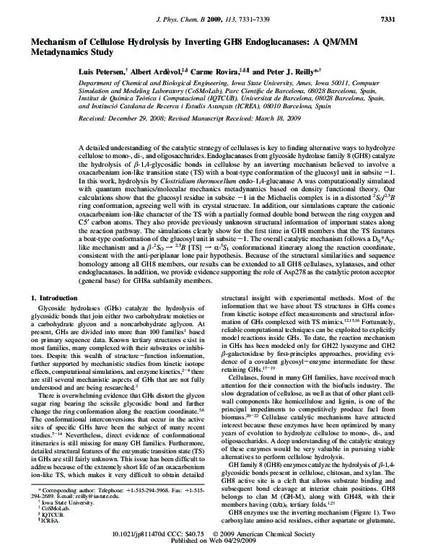
A detailed understanding of the catalytic strategy of cellulases is key to finding alternative ways to hydrolyze cellulose to mono-, di-, and oligosaccharides. Endoglucanases from glycoside hydrolase family 8 (GH8) catalyze the hydrolysis of β-1,4-glycosidic bonds in cellulose by an inverting mechanism believed to involve a oxacarbenium ion-like transition state (TS) with a boat-type conformation of the glucosyl unit in subsite −1. In this work, hydrolysis by Clostridium thermocellum endo-1,4-glucanase A was computationally simulated with quantum mechanics/molecular mechanics metadynamics based on density functional theory. Our calculations show that the glucosyl residue in subsite −1 in the Michaelis complex is in a distorted 2SO/2,5B ring conformation, agreeing well with its crystal structure. In addition, our simulations capture the cationic oxacarbenium ion-like character of the TS with a partially formed double bond between the ring oxygen and C5′ carbon atoms. They also provide previously unknown structural information of important states along the reaction pathway. The simulations clearly show for the first time in GH8 members that the TS features a boat-type conformation of the glucosyl unit in subsite −1. The overall catalytic mechanism follows a DN*AN-like mechanism and a β-2SO → 2,5B [TS] → α-5S1 conformational itinerary along the reaction coordinate, consistent with the anti-periplanar lone pair hypothesis. Because of the structural similarities and sequence homology among all GH8 members, our results can be extended to all GH8 cellulases, xylanases, and other endoglucanases. In addition, we provide evidence supporting the role of Asp278 as the catalytic proton acceptor (general base) for GH8a subfamily members.
Available at: http://works.bepress.com/peter_reilly/35/

Posted with permission from The Journal of Physical Chemistry B, 113, no. 20 (2009): 7331–7339, doi:10.1021/jp811470d. Copyright 2009 American Chemical Society.